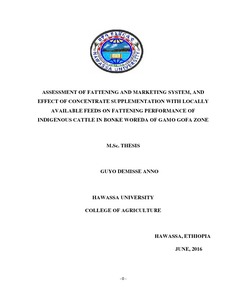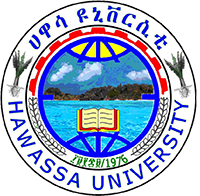Resource information
The study was carried out in Bonke Woreda of Gamo Gofa Zone, southern Ethiopia, with the objectives of assessment of fattening and marketing system, and effect of concentrate supplementation with locally available feeds on fattening performance of indigenous cattle. The study involved survey to assess cattle fattening and marketing practices, and action research to evaluate the effect of homemade concentrate from locally available feed resources on fattening performance and economic return of indigenous cattle. The survey part involved interviewing 120 households purposively selected from six kebeles in three agro ecologies. Focus group discussions and key informants have been employed to enrich the data. The feeding trial was conducted in Danible Ottora Kebele,with 18 (9 castrate and 9 non – castrate) indigenous cattle for 70 days excluding adaptation period of 15 days. Treatments included farmer’s practices alone (T1); T1 + concentrate supplementation at 1% of body weight (T2); and T1 + concentrate supplementation at 1.5% of body weight (T3). Maize stover and stubble grazing was provided as a basic ration which was the farmers feeding practice. Experimental animals were blocked by farms/households and randomly assigned to three feeding treatments separately. Heart girth and body condition score were recorded while body weight was estimated from heart girth using regression equation developed for zebu cattle. The data were analyzed using the General Linear Model Procedure of statistical package for Social Science (SPSS 16). The result showed that the most dominant cattle breed used for fattening in the study area was indigenous. The major source of cattle for fattening was through purchasing from market (69.1%) followed by raising at home (24.2%). Almost all fatteners in highland (95%) and mid-altitude (100%) were engaged in fattening castrate. Concerning physiological stage of the fattening animals, most of the producers (83%) use matured & old oxen. In highland, majority of the farmers fatten cattle once within a year (60%), while it was three times per year for mid-altitude (42.5%) and two times per year for lowland (70%) agro-ecologies. The majority (90%) of the respondents indicated that the most common criteria used to decide fattening period was body condition of the animals. Majority of the respondents in the highland, mid altitude and lowland fatten cattle for six months, three months and five months, respectively. The major types of feed resources for the fattening animal were natural pasture, crop residues, stubble grazing, grass hay and feed supplements. The major criteria used while purchasing fattening cattle included frame size, heath, body condition, coat color and price of animals. The experience in cattle fattening, large cattle population, diverse & suitable agroecology, availability of crop residues, high irrigation potential, initiation of the introduction of improved forage species and cheap labor force reveals the potential of the area for improved cattle fattening. However, feed shortage, shortage of land, prevalence of disease, poor access for credit service and marketing information, and underdeveloped cattle marketing were the major constraints that hinder the performance of cattle fattening. The feeding trial showed that average daily gain were highest (p<0.05) for animals supplemented with T3 followed by T2 and T1. Similarly, the net return was higher (P<0.05) for the supplemented group (T2 & T3) compared to non-supplemented group kept under farmers management (T1). Among the supplemented groups, marginal rate of return was higher for animals supplemented with T2 compared to T3. Thus, it can be concluded that when resources are not meager smallholders producers could use supplementation at 1.5% of body weight for higher return. However, when resources are limited producers are advised to supplement at 1% of body weight for higher marginal rate of return. Detail research work on availability, nutrient composition and digestibility of the major feed resource are recommended for further work.



